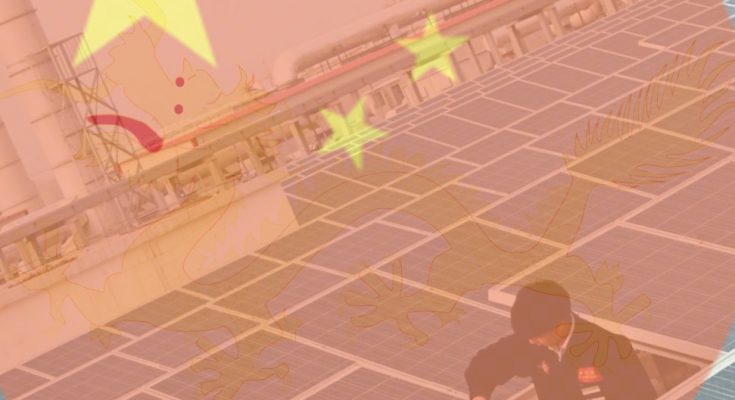The country is prone to excruciating air pollution, fears climate change and wants to become a “monster” of the renewable energy industry.
HAINING, CHINA – Barely thicker than a sheet of paper, the silicon plates are about six inches by six inches each and have thin bands of silver. They arrive in the factory by the thousands, packaged in cardboard boxes, before leaving a few hours later.
These plates are actually solar panels. In this factory, a two-hour drive from Shanghai, workers dressed in bright blue uniforms are at the controls of the machines that assemble them row after row into more familiar-looking panels ready to be installed. on rooftops into a vast array and transform the sun’s rays into electricity.
Chinese industry has transformed the renewable energy economy around the world, making solar power generation competitive with electricity from fossil fuels like natural gas or even coal. It has also democratized change, thanks to China’s investment in clean energy (the largest in the world), driven in part by the desire to reduce the appalling air pollution that kills around 1 year. , 1 million of its inhabitants.
“The number of installations is absolutely staggering,” says Lauri Myllyvirta, energy and air pollution expert at Greenpeace in Beijing. In 2016 alone, China added 35 gigawatts of solar power. “It’s almost the equivalent of Germany’s total capacity, in just a year,” he explains.
According to Greenpeace estimates , China is erecting a new wind turbine every hour and installing enough solar panels to cover a soccer field.
AFTER-COAL
After years of ignoring the air quality crisis, the result of decades of rampant industrialization, China’s leaders have finally taken steps to resolve it. Since coal is the source of around 40% of the most dangerous fine particles in the country’s air, the search for alternative solutions has become a priority. China’s goal is to produce 20% of its energy from renewable energy sources by 2030; to this end, it recently announced that it would invest 360 billion dollars over the next three years.
In the Yangtze River Delta, a region known for its economic dynamism, Jinko Solar is one of the companies that has emerged to meet this demand. It also exports its solar equipment to the United States, Europe, Latin America, the Middle East and all over the world. Last year, it produced panels with an electricity generating capacity equivalent to that of around 10 coal-fired power plants.
In Haining, as the factory floor shines and a faint breath serves as the only background sound, red robot arms rise and twist, moving panels from post to post. Equipped with white masks covering their face and head or colorful baseball caps screwed to their heads, workers test and adjust the layers that accumulate, the parts sealed in ready-made modules and the wires that protrude from them. ‘a small black box mounted on the back.
While air pollution is not the only reason for China’s recognition of the importance of renewable energies, it has played a key role. In a major agreement signed with President Obama in 2014, President Xi Jinping pledged to reduce Chinese CO2 emissions responsible for global warming by 2030: a promise that has become the centerpiece of his commitments within the framework of of the Paris climate agreement.
It now appears that China is ahead of its agenda. As reliable as the official figures may be, they nevertheless indicate a drop in coal consumption in 2016 for the third consecutive year , the main driver of China’s carbon emissions. The country has understood that this decision to reduce coal is in its own interest (the fuel powers much of its heavy industry and produces electricity); this trend is likely to continue despite the abandonment by the United States, under the Trump administration, of former President Obama’s dedicated climate program.
China is responsible for half of the world’s coal consumption, so this is good news not only for the health of Chinese citizens, but also for the broader effort to curb the surge. of global warming.
“To be completely honest, I think these measures would not have been taken so quickly and in the face of so little resistance if they had not been motivated by the problem of air pollution,” says Myllyvirta . “It’s hard to dispute them and deny the obvious when you breathe the poisonous Beijing air. ”
FAILURES IN THE NETWORK
The development of renewable energies has not been easy. Vast fields of wind turbines have been built in the sparsely populated areas of the northwest, far from the big cities where electricity needs are greatest, and the construction of power transmission lines to supply them with electricity does did not follow.
“They are building huge wind farms but have no connection to the grid,” explains Antung Liu of Indiana University at Bloomington. “They take the posture of, ‘let’s build and hope we can use it later.’ ”
In addition, network operators have shown a bias in favor of coal production and clean energy has sometimes been unused even when the connections exist. According to Greenpeace estimates, 19% of Chinese wind power was wasted in the first three quarters of last year.
Leaders are now starting to take these issues into account, installing new power lines and focusing on building smaller wind farms and solar power plants in densely populated areas.
Initially, China’s effort “was just to increase the number of gigawatts,” says Jukka-Pekka Mäkinen, CEO of The Switch, a Finnish company that produces components for wind power in China. “It is now a question of maintaining the number of gigawatts, but in a much smarter way by focusing on regions where consumption is high. ”
Despite these efforts, China continues to build coal-fired power plants, not least because of an incentive policy that encourages local officials to allow redundant construction, even as the central government seeks to push for cleaner options. However, officials have canceled some planned, well aware that China already produces more coal-fired electricity than it needs.
AN INDUSTRIAL MONSTER
Pollution is not the only cause behind this enthusiasm for renewable energies. Leaders see clean energy as a powerful job creation driver.
“It’s about establishing industrial dominance,” explains Antung Liu. “China sees green energy as an opportunity to become an industrial monster just as it has seen in textiles and toys. ”
Whatever his motivations, the consequences of this attraction for clean energies on the part of China are already being felt. The richest countries that once used China as a pretext to evade their own inaction are now watching it overtake them at full speed to become a world leader on the climate issue.
“Everyone kept repeating: ‘China did not sign the Kyoto accord'”, the 1997 climate agreement, recalls Jukka-Pekka Mäkinen. ” So what ? It has done more than all the countries put together. ”



